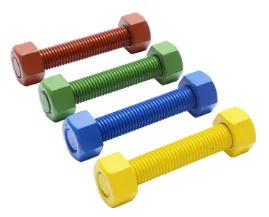Stud Bolt: A Strong Link Connecting the World
Aug . 13, 2025 11:43 Khutlela lethathamong
Stud Bolt: A Strong Link Connecting the World
In the connection system between mechanical manufacturing and engineering construction, Stud Bolt has become an indispensable key connector in many fields with its unique structure and reliable performance, silently undertaking the mission of high-strength and high-precision connection.

The structural design of Stud Bolt is highly practical
The double end stud bolts are machined with external threads on both ends, and the middle part is a bare rod without threads, which allows them to play a unique role in the connection. The threads on both ends can be matched with different connectors, with one end screwed into the threaded hole of the connected component and the other end fastened with a nut to form a stable connection structure. The length of the light rod part is precisely designed according to the connection requirements, ensuring that the connected components maintain appropriate distance and position relationship, while reducing the stress concentration on the threaded part and improving the overall connection strength.
The material selection of Stud Bolt needs to balance strength and environmental adaptability
For general working conditions, B7 Stud Bolts made of ordinary carbon steel have a high cost performance ratio and can meet conventional connection requirements; In high-pressure and high-temperature environments, such as chemical equipment, boiler systems, etc., alloy structural steel is often used. After quenching and tempering treatment, it has excellent high temperature and high pressure resistance performance; In humid and highly corrosive environments, stainless steel Stud Bolt, with its excellent corrosion resistance, can maintain the stability of the connection for a long time.
The application scenarios of Stud Bolt are extensive and critical
In the manufacturing of pressure vessels, the head is tightly connected to the cylinder to ensure that the equipment does not leak in high-pressure environments; The connection between the bearing seat of large mechanical equipment and the body often relies on Black Coating Stud Bolts to provide stable fastening force, ensuring the accuracy of equipment operation; In bridge and steel structure construction projects, Stud Bolt is used to connect key load-bearing components, transmit huge loads, and maintain the overall stability of the structure; In addition, Stud Bolt also plays an important connecting role in fields such as automotive engines and marine power systems.
With the development of industrial technology, Stud Bolt is constantly undergoing technological innovation
To improve the anti loosening performance, some zinc plated stud bolt adopt designs such as thread coating and end slotting, effectively preventing loosening in vibration environments; The high-strength Stud Bolt has further improved its tensile strength and yield strength through advanced heat treatment processes, meeting the connection requirements of ultra-high pressure and heavy-duty equipment; At the same time, in response to the special needs of specific industries, irregular Stud Bolts have also emerged, whose thread sizes and tooth shapes at both ends can be customized according to actual connection requirements, enhancing the adaptability of the connection.
In summary, Stud Bolt occupies an important position in the field of connectivity with its unique structural design, diverse material selection, wide range of application scenarios, and continuous technological innovation. Although its structure may seem simple, it ensures the stable operation of various equipment and engineering structures with reliable connection performance. In the future, with the continuous improvement of connectivity requirements in the industrial field, Stud Bolt will continue to break through in performance and applicability, and continue to play an irreplaceable role in connectivity.
Stud Bolt FAQs
What is Stud Bolt?
Stud Bolt is a type of fastener with threads on both ends, typically consisting of a bare stem without threads in the middle. It is commonly used in connection scenarios that require high strength, such as pipeline flanges, pressure vessels, etc., by being used in conjunction with nuts.
What is the difference between Stud Bolt and regular bolt?
Ordinary bolts are usually single threaded (with one end threaded and the other end being the bolt head), while Stud bolts have threads on both ends and need to be used with two nuts. The installation and disassembly of Stud Bolt are more flexible, suitable for occasions that require frequent maintenance or high demands for accuracy.
What are the commonly used materials for Stud Bolt?
Common materials include carbon steel (such as ASTM A193 B7), stainless steel (such as AISI 304/316), alloy steel (such as A193 B16), etc. When selecting, environmental corrosiveness, temperature, and pressure requirements should be considered.
How to install Stud Bolt correctly?
Ensure that the threads are clean and undamaged, and use lubricant if necessary.
Manually screw one end of the thread into the flange hole to avoid misalignment.
Use a torque wrench to tighten the nuts in a symmetrical sequence, gradually reaching the specified torque value.
What are the reasons for the failure of Stud Bolt?
Overload: Exceeding the tensile or shear force that the material can withstand.
Corrosion: The mismatch between the material and the environment leads to rusting or stress corrosion cracking.
Improper installation: such as uneven torque, damaged threads, or misalignment.
Fatigue: Long term cyclic loading leads to crack propagation.
Litaba tsa moraorao
-
Bolts for Lawn Mower Handle Supplier | OEM & Rust-Resistant
LitabaNov.17,2025
-
Silver Screws Supplier | Corrosion-Resistant, Bulk & Custom
LitabaNov.17,2025
-
Cabinet Bolts Supplier | OEM, Bulk Stock, Fast Shipping
LitabaNov.17,2025
-
Axle Nuts Supplier - OEM-Grade, ISO-Certified, Fast Delivery
LitabaNov.17,2025
-
Wire Bolts Suppliers – OEM Factory Prices, ISO Quality
LitabaNov.11,2025
-
Bolts for Lawn Mower Handle Supplier – OEM & Anti‑Rust
LitabaNov.11,2025
